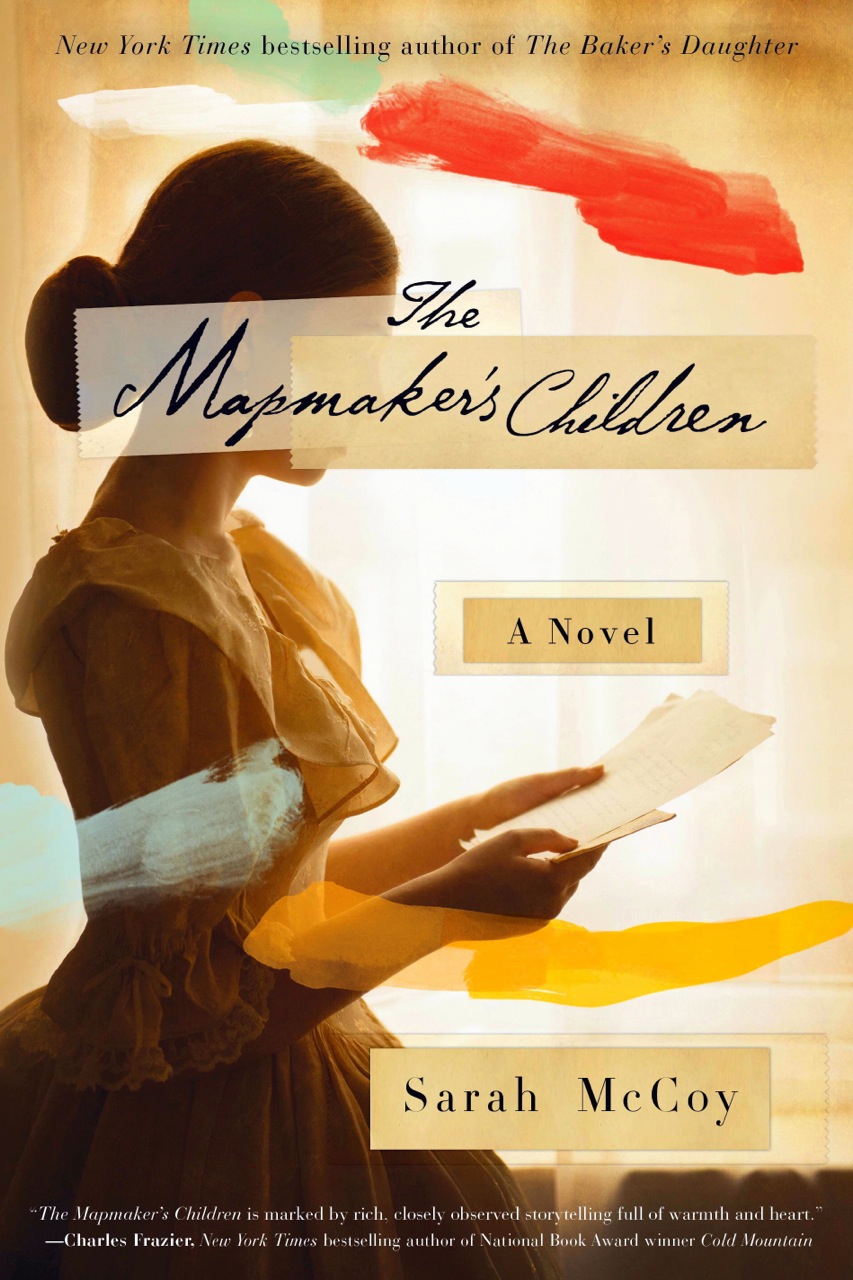Sarah McCoy talks dual narratives, Skyping with book clubs & going without showers

I met Sarah McCoy for the first time at the 2012 Gaithersburg Book Festival. She was there promoting her new-at-that-time book, “The Baker’s Daughter,” which The New York Daily News called “intricate and delicious.”
I remember thinking she looked so young to already be a New York Times best-seller, to have such success. But I can’t think of anyone who deserves it more than this wonderfully talented and gracious author, a woman whose love of Skyping with book groups is perhaps only surpassed by her love of her husband (Doc B) and her adorable dog. I was so excited when I heard she was coming back this year, and couldn’t wait to read her latest, “The Mapmaker’s Children” (due out in May), and do a Q&A with her. (I also can’t wait to see her again in May.)
Your last two books — “The Baker’s Daughter” and “The Mapmaker’s Children” — have both involved dual storylines, one set in the present and one in the past. What is it about that structure that is so compelling to you?
Writing two storylines in a historical-contemporary hybrid form seems to be my organic way of processing whatever fictional worlds I’m working in. I study history through a kind of Alice in Wonderland looking-glass filter of the present. I wrote that way for “The Baker’s Daughter” and now again in “The Mapmaker’s Children.” I’m fascinated by how the people of the past can reach across generations and impact the present; how mysteries of the present have their solutions in the past; how issues we face and decisions we make today are strikingly similar to ones our forbearers made—with good and bad outcomes. I’m riveted by this interplay.
I think it’s important we don’t just read and compartmentalize the past as an “interesting story.” I want my readers to see that the history is a key, a manual, a lesson guidebook for us to learn and implement change in our present lives.
How do you balance creating two storylines that intersect/relate to each other but aren’t identical?
Very carefully. Can you hear me cackling as I say that? It’s a maniacal process, and I’m sure my agent and editors wish to God I’d just go on and write a straight contemporary or straight historical novel but… alas, ’tis not my style. For “The Baker’s Daughter,” I wrote back and forth as I pleased and in the end, had to tear the entire narrative apart and line up the plots to ensure the seams fit.
For “The Mapmaker’s Children,” I tried to be more methodical by first outlining each character’s narrative trajectory— their start-to-finish story. Using that as a map (no pun intended), I set into writing back and forth chapters allowing that outline to guide me but also to transform, meander, and lead me to new territory as the characters organically commanded. While it was a more organized creative process from “The Baker’s Daughter,” it proved evermore daunting in my inclusion of historical information. At one point, I handed over an 800+ page manuscript to my (bless her heart) agent who lovingly read and helped me shave off some areas before giving it to my publisher. My editor was brilliant but ruthless. She told me to half the book. Cut it down from 800 to under 400 pages, and I did it over the course of 6 months. It was a page bloodbath to say the least.
Where do your ideas come from?
My husband, Doc B, has been asking me this for years. Lord only knows. They are celestial lightning bolts that never come from the same direction or source.
What is the biggest challenge in writing historical storylines?
I’d say the hardest part of writing historical storylines is being faithful to the facts while developing the fiction. It’s hard work and in my humble opinion, the cardinal sin is to misinform or trick readers. I want my readers to learn truth from my stories — be it the sequence of historical events or an emotional journey. The characters must be authentic to their place and time. Therefore, as the author, my writing must be authentic to them. It’s extremely challenging to juggle the narrative balls of two time periods: contemporary and historical. But I like a challenge in my writing. Sarah Brown was a get-down-in-the-trenches pioneer woman who didn’t mind that her fingers were stained with her life’s work. I take great inspiration from her legacy. I think she’d agree with Teddy Roosevelt who said: Nothing in the world is worth having or worth doing unless it means effort, pain, difficulty… Some people might think that a harsh worldview, but I find it galvanizing.
How do you tackle writing stories that take place in locations that you’ve never visited?
I love to travel, to experience other cultures and discover cities with ancient pasts. But I’m also a homebody. My writing office is my sanctuary. When I’m away from it, I yearn to be back just as passionately as I yearned to venture out into the world. So writing about places I’ve never visited is a kind of vicarious travel. I find it thrilling and deeply satisfying to delve into any book featuring a setting that’s foreign to my sphere of experience. I try to take readers on a similar adventure. To do so, I research and read a lot about the location. From nonfiction cultural analogs, tourism guidebooks and cookbooks to fiction written by native authors and authors who, like me, were visitors. All of it is invaluable to helping me stand inside my characters and tell their story as it is seen, heard, smelled, tasted, and felt — for it to be as true as possible to the imaginary vision. A paradoxical tightrope, but it’s part of the craft I relish. That artful weaving of fact and fiction to create something wholly its own.
What is your favorite part about interacting with readers?
In today’s tech-savvy literary community, social media (Twitter, Facebook, Pinterest, Goodreads, Skype, etc.) is like a grand author-reader carnival! Despite being across the nation (and for my international readers, across the globe), I’m able to share immediate conversations about everything from books to what we’re each making for dinner. I thoroughly enjoy being in touch online, and it makes it even more of a treat when those same reader friends come out to events like our Gaithersburg Book Festival. Then we’re able to bridge that virtual-reality gap, and all those “Likes” and “Favorites” manifest in tangible hugs. There’s truly nothing better for an author. I’m looking forward to doing just that on May 16, 2015.
What is the funniest/best question you’ve ever been asked by a reader?
I had a fabulous book club ask me via Skype: What’s the longest you’ve gone without showering or changing clothes while writing? I answer honestly, but… as I’ve told all the book clubs I’ve been privileged to visit, I only air such ‘dirty laundry’ in face-to-face virtual affairs. So if you’re craving to know the answer, you’ll simply have to read my new book and arrange a club Skype. Then, I shall be your open book.
Do you have a favorite among your children (i.e., your books)? If so, why?
And just as any devoted mother would reply: I love all my children equally and eternally! That said, I can tell you that I put more blood, sweat, tears, and time into “The Mapmaker’s Children” than any of my previous books. I think it’s my best work yet, and I pray readers agree. I’m always trying to take it up another notch in my fiction. It keeps the writing — and reading — fresh and exciting.
 Sarah McCoy is the New York Times, USA Today and international best-selling author of the novels “The Baker’s Daughter,” a 2012 Goodreads Choice Award Nominee, and “The Time It Snowed In Puerto Rico” and of “The Branch of Hazel: a novella,” which can be found in the anthology, “Grand Central.” Her next novel, “The Mapmaker’s Children,” is due out in May 2015. Her work has been featured in Real Simple, The Millions, Your Health Monthly and other publications. She has taught English writing at Old Dominion University and at the University of Texas at El Paso.
Sarah McCoy is the New York Times, USA Today and international best-selling author of the novels “The Baker’s Daughter,” a 2012 Goodreads Choice Award Nominee, and “The Time It Snowed In Puerto Rico” and of “The Branch of Hazel: a novella,” which can be found in the anthology, “Grand Central.” Her next novel, “The Mapmaker’s Children,” is due out in May 2015. Her work has been featured in Real Simple, The Millions, Your Health Monthly and other publications. She has taught English writing at Old Dominion University and at the University of Texas at El Paso.


